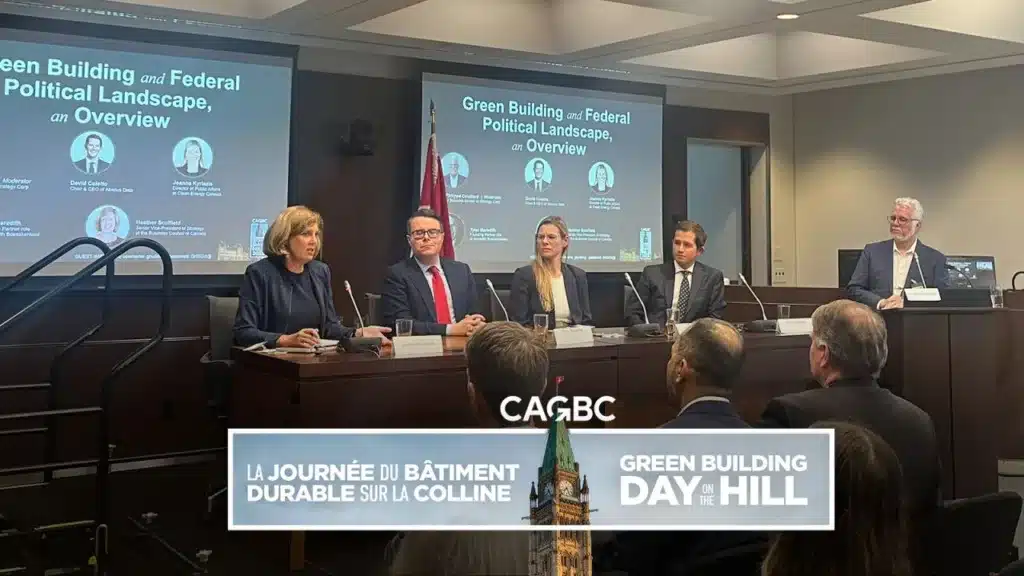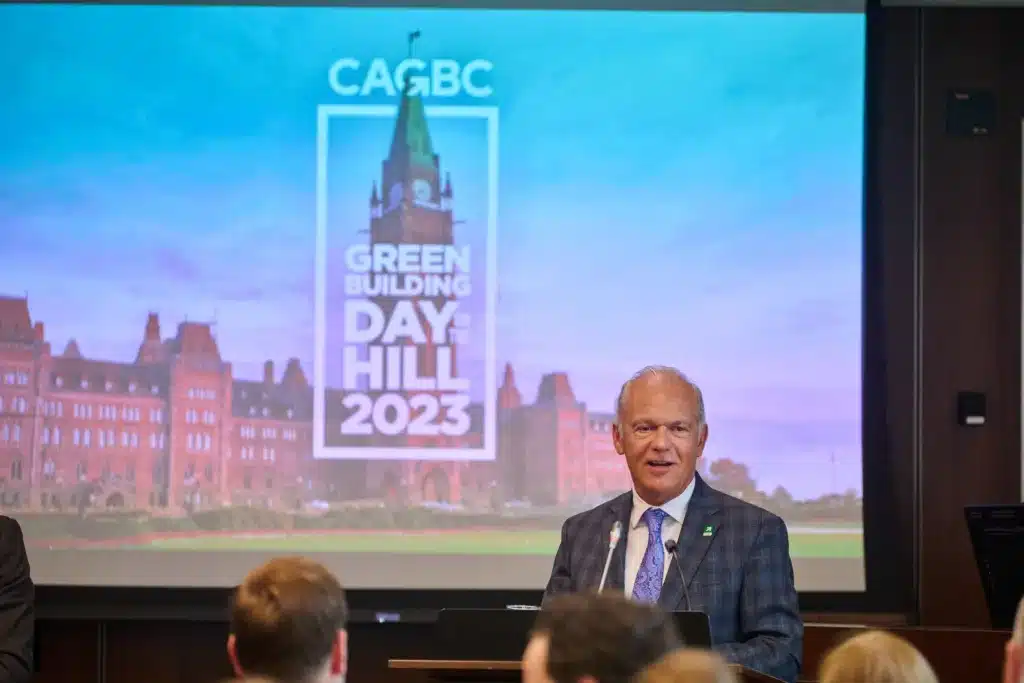Is Budget 2024 a “green building” budget?
Jean-Marc Fagelson, Advisor, Advocacy and Government Relations, CAGBC on June 19, 2024
- Theme
- Advocacy
With the House of Commons adjourned for the summer, the article analyzes Budget 2024
Budget 2024 represents a slowdown in federal investment in green buildings, at a time when international markets are ramping up investments and regulations for carbon reductions. Yet, there is reason for optimism in the measures announced, such as housing and investment tax credits.
CAGBC’s Budget 2024 recommendations
Let’s start with the Canada Green Building Council’s (CAGBC) three recommendations for Budget 2024.
Out of the three recommendations CAGBC provided, two were related to the Canada Green Buildings Strategy (CGBS). They included funding to support transition planning, and supports for building data capacity.
Budget 2024 provides $900+ million for the implementation of the CGBS through three core initiatives:
- $800 million for Canada Greener Homes Affordability Program, a home retrofit program targeting low-and median-income households that will start in 2025-2026.
- $30 million “to continue developing a national approach to home energy labelling” which will start in 2024-2025.
- $73.5 million to renew and modernize energy efficiency tools such as ISO 50001 Energy Management Systems Standard and the ENERGY STAR Portfolio Manager, starting in 2024-2025.
Unfortunately, these initiatives will receive just 8.5 percent of the budgeted funding between now and Q2 2026. In other words, only $77 million will be available to Natural Resources Canada to implement the CGBS by the time a new government is elected.
CAGBC’s third recommendation was for a grant program to support Canadian small and medium manufacturers seeking a Life Cycle Assessment (LCA) or an Environmental Product Declarations (EPD) for their low-carbon construction materials, supporting the implementation of the Buy Clean Strategy. Unfortunately, there is no funding attached to the Buy Clean Strategy in Budget 2024.

Funding for green community buildings, federal assets
By providing $500 million over five years to the Green and Inclusive Community Buildings Program, Budget 2024 is continuing to support new zero-carbon buildings and deep building retrofits in communities across Canada. This major investment supports local and indigenous governments and provides better, future-proofed public facilities.
Budget 2024 also proposes to provide $6.7 billion over 20 years, starting in 2024-25, to Public Services and Procurement Canada (PSPC) to manage its portfolio of assets. This investment supports the ambitious policy to focus on carbon reductions in new and existing buildings and leases via the Greening Government Strategy(GGS), yet PSPC will only receive $181 million in the next couple of years.

Housing: Use of public lands & technology in support of new homes
Budget 2024 rightly focused on increasing housing supply as a method of restoring housing affordability, a critical bread-and-butter issue for Canadians. However, in the rush to create more housing, we risk putting quantity over quality. By not including energy efficiency measures to guide how new housing is built, we risk creating millions of new homes that will add to carbon emissions and burden future homeowners with increased energy costs and potentially expensive retrofits.
Among the measures in the Budget was the Building Homes on Public Lands program, which allocates $1.1 billion over 10 years to leverage government-owned properties for housing.
This funding, which is expected to be fully recovered through substantial short- and long-term cost savings, will help to accelerate the disposal of underused owned or leased federal properties.
The federal government will also study building on land owned by Canada Post and National Defense. Both entities have committed to decarbonization, and sustainable housing on their land would make sense. Budget 2024 opens the door to buying provincial, territorial and municipal land for housing purposes. Further, it allows for the conversion of government-owned office buildings into housing, including (where applicable) for student and non-market housing.

Technology in support of energy-efficient homes
The Budget also allocates funds to Changing How We Build Homes. The program provides $100 million over two years to support investments in innovative technologies such as Mass Timber construction, 3D printing, modular homes, and manufacturing techniques.
Beginning in 2024-25, there will be $50 million available over two years for Next Generation Manufacturing Canada (NGen), to help launch a new Homebuilding Technology and Innovation Fund. NGen will seek an additional $150 million from the private sector for a targeted $200 million investment. An additional $50 million is proposed to scale-up more innovative housing solutions, through Canada’s Regional Development Agencies, allocated over two years.
Unlocking financing for housing & business in purpose-built rental building
One way Budget 2024 strives to accelerate housing development is through access to financing.
However, in most programs, there is either no energy efficiency or GHG reduction requirement (Housing Accelerator Fund) or there is dependency on old building code references (2015). Financing that is not tied to any requirements for energy efficiency requirements or carbon reductions is a significant miss.
Furthermore, there are discrepancies between what is demanded of provinces and territories and what is demanded within federal programs. For example, in the Housing Infrastructure Fund the federal government is asking provinces and territories to adopt the latest version of building codes, while the Apartment Construction Loan Program is only requesting a 15% energy reduction compared to the 2015 building codes. The federal government needs to be consistent and, at minimum, use the latest model energy building codes (2020) or ensure alignment with the proposed new national building codes to be released in 2025, while also making carbon emissions reduction a requirement.
There is still time for the new version of the Apartment Construction Loan Program to support energy-efficient and low-carbon housing for renters. By starting the new program in 2025-2026 and adding $15 billion to this loan funding, this program has great potential.
In addition to eliminating the GST from new rental housing projects and providing low-cost financing, Budget 2024 proposes a temporary accelerated capital cost allowance at a rate of 10 percent for eligible new purpose-built rental projects. This new capital cost allowance rate will incentivize builders through increased after-tax returns on investment. This measure would cost an estimated $1.1 billion over five years, starting in 2024-25.

CAGBC’s focus: Advocacy & implementation
Overall,Budget 2024 provides impactful measures such as the new round of funding for the Green and Inclusive Community Buildings program and other initiatives that could change the market significantly, especially on the housing front. While the CGBS doesn’t have enough funding for the next 18 months, the policy will need to include the principles that Canada endorsed in the declaration of Chaillot in Paris: near-zero emissions by 2030, sustainable and affordable housing, and the use of low-carbon construction materials to ensure Canada remains on track with its international commitments.
CAGBC’s Advocacy team will continue working to improve alignment between the urgency to act on housing and the imperative to provide highly efficient homes and workplaces for Canadians.